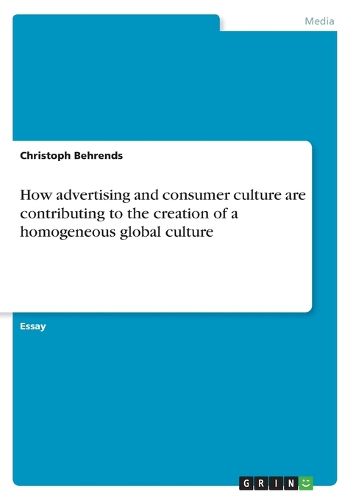Readings Newsletter
Become a Readings Member to make your shopping experience even easier.
Sign in or sign up for free!
You’re not far away from qualifying for FREE standard shipping within Australia
You’ve qualified for FREE standard shipping within Australia
The cart is loading…






Essay from the year 2005 in the subject Communications - Mass Media, grade: 1,7, University of Leicester (University of Leicester - Centre for Mass Communication Research), course: Advertising, Culture and Communication, 16 entries in the bibliography, language: English, abstract: Urban dwellers in the Western world have witnessed a change of their cityscapes recently. Small independent stores, restaurants and coffee bars have been replaced by stores of multinational companies, such as Tesco, McDonald’s, Burgerking, Starbucks, H&M and The Gap. No matter if you are exploring the city centre of Leicester, London or Hamburg, you find more and more branches of large-scale business companies, attempting to attract consumers with their big, bright logos. The same process can be found in the media - global brands such as Hewlett-Packard and Coca Cola advertise all around the globe, or in terms of Barnet et al (1995: p. 164): Marlboro country is everywhere . While the unification of city centres has been much-discussed, further questions need to be elaborated on: In how far are these phenomena results of globalisation? Which consequences do they have for life in Western societies? Is there a global homogenisation of culture, and if so, to what extent? Which role does advertising play in this process? These and other questions are discussed in this paper.
$9.00 standard shipping within Australia
FREE standard shipping within Australia for orders over $100.00
Express & International shipping calculated at checkout
Essay from the year 2005 in the subject Communications - Mass Media, grade: 1,7, University of Leicester (University of Leicester - Centre for Mass Communication Research), course: Advertising, Culture and Communication, 16 entries in the bibliography, language: English, abstract: Urban dwellers in the Western world have witnessed a change of their cityscapes recently. Small independent stores, restaurants and coffee bars have been replaced by stores of multinational companies, such as Tesco, McDonald’s, Burgerking, Starbucks, H&M and The Gap. No matter if you are exploring the city centre of Leicester, London or Hamburg, you find more and more branches of large-scale business companies, attempting to attract consumers with their big, bright logos. The same process can be found in the media - global brands such as Hewlett-Packard and Coca Cola advertise all around the globe, or in terms of Barnet et al (1995: p. 164): Marlboro country is everywhere . While the unification of city centres has been much-discussed, further questions need to be elaborated on: In how far are these phenomena results of globalisation? Which consequences do they have for life in Western societies? Is there a global homogenisation of culture, and if so, to what extent? Which role does advertising play in this process? These and other questions are discussed in this paper.